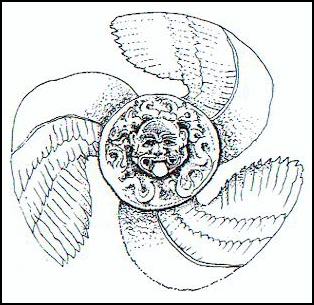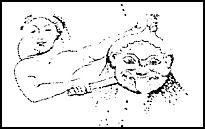
to compose sequences of « myth cinema »
TABLE OF CONTENTS
Home page
The awaited return of the most obvious seasonal signal
The "brilliant" sectors of the sky
An assembly of sacred images
Figures portrayed
by stars in the night,
by nature "dramatic" figures
Why make reference to
seasonal stars.
Measuring time in "moons"
When lunar imagery is combined
with stellar imagery to compose
a "mythical cinema"
The human condition
and its development
in the
collective memory
More
French version
The metamorphoses of lunar imagery:
Comparisons and a repertory of names
The changes in the Moon’s image, its "phases" are inescapable indicators of the date within the month. Moon phases were a source of comparison and of names of remarkable importance in the creating myths.

The series of three successive and characteristic forms, Waxing Crescent, Full and Waning Crescent inspired recurring themes such as "Three Brothers" and more often the "Three Sisters" that reign in numerous tales. The most beautiful of these "princesses" is obviously the Full Moon, with its "irresistible" attraction, often the object of the animosity of its lesser luminaries (Greece: myth of Psyche and her sisters, myth of Three daughters of Tyndareus: Phoebe, has remained a name of the Moon, Helene = Selene = Full Moon, "Beautiful Helen" and Clytemnestra, the daunting herald of sacrifices)
The roundness of the Full Moon
It is easy to imagine how and why the Moon continued to catch man’s spirit and inspire his imagination. What the Full Moon represented:
A "Bodiless Head". The Full Moon resembles a face (Egypt: Ptah: "beautiful face"). Round white face, eyes placed high, no nose, wide open mouth.

This head is radiant (see images of Dionysus in major Greco-Roman mosaics… where a set of concentric curves are drawn around the numbers 12 and 13, which are encircled with symbols of the seasons).
This head gradually pulls on its cap of invisibility. This covering of invisibility characterizes the mythical figures that originated with the Moon (Hermes, Ptah, Pierrot with his skullcap, Phrygian cap, the cap of the Anatolian god Men, etc).
The bodiless Head was the victim of a decapitation: key image that inspired many myths (Celtic: Bran; Slave: Menuo et Perkunas; Egyptian: Isis; Greek: the Gorgon Medusa and Perseus, Orpheus, Dionysus, etc. and the bodiless head often turns up in the chronicles of Christianity: Saint Denis, etc). Source of imitative sacrificial rites (Latin: supplicium, the "supplication of the gods" = beheading, "capital" punishment)

This image of a "flying head without a body" inspires, among other manifestations, the ritual Ball Game of the Mayas, which mirrors the course of the Moon among fixed stars and the passage of vital seasonal energies. The Popl Vuh, sacred book of the Maya, explains: the Ball Game precedes the descent of the hero-savior into the kingdom of the Dead (Chibalba). At the end of these games, the best players are sacrificed. It would not be too great an exaggeration to see crowd reactions during today’s major soccer events as vestiges of sacrificial archetypes from prehistoric religious ceremonies… part of the fans’ collective unconscious.
The noun "Head", is the same as "ball" and "pebble" (Egypt: kHor, Greece: kar, karè) and appears in the names of very ancient lunar powers:
KhR ,
Khar, Kher, Khor, Hor
The name of the power that governs Time (Kronos/Khronos, Kernunnos, Horus), and the term for "circular" movement (Krk), similar to the circling of a bird of prey (Horus: falcon, Kirke, Circe: power of metamorphosis and hawk) are combined to make the name. It also evokes decisive religious periods of the calendar cycle (horus: sacred moment) and the site of the gathering "in a circle" (circus, church) where the immemorial rite of the circular dance takes place (khorus)…